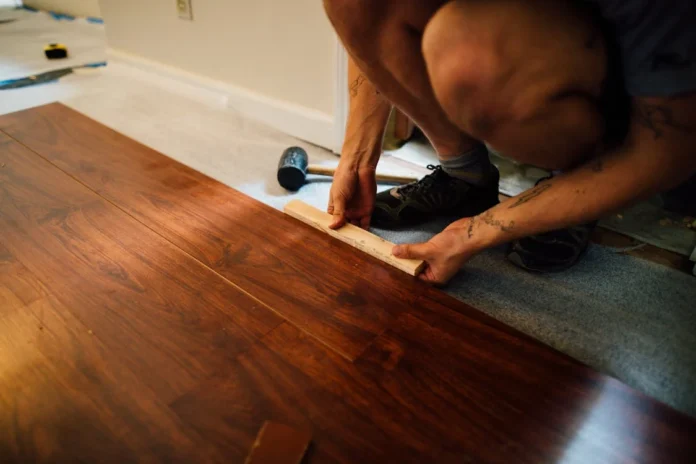Table of Contents
Key Takeaways
- Laminate flooring is an affordable and flexible choice for numerous homeowners.
- Grasping the different elements that influence installation expenses can aid in optimizing savings.
- Proper preparation and maintenance significantly enhance the lifespan of laminate flooring.
What is Laminate Flooring?
Laminate flooring has evolved over the years as a preferred option for homeowners seeking an aesthetic and practical alternative to traditional flooring. It is a composite product designed to simulate the look of hardwood, stone, or other natural finishes. Made of multiple layers combined through lamination, this flooring option provides benefits beyond mere aesthetics. The topmost layer acts as a hard-wearing shield, guarding against daily wear and tear, while the inner layers provide strength and stability. Given its composition, it’s easy to see why many opt for affordable laminate flooring installation as a cost-effective way to enhance the look of their homes.
Benefits of Laminate Flooring
Laminate flooring is a cost-effective, low-maintenance option widely admired for its adaptability. One of its standout features is its affordability, making it accessible even to budget-conscious homeowners. Beyond price, the variety of styles is vast, ranging from authentic wood grain textures to sleek stone finishes. These design features suit every taste, ensuring each space has the potential to reflect its owner’s personality. Moreover, its ability to resist scratches and dents makes it ideal for bustling households and active spaces. On the environmental front, many manufacturers are adopting sustainable practices by incorporating recycled materials, thus making laminate an eco-friendly option for the modern home.
Factors Affecting Installation Cost
Understanding the cost of laminate flooring installation involves numerous variables. The quality of the laminate itself can significantly influence the overall expense. Premium options, though pricier, often guarantee longevity and superior aesthetic finishes, providing better overall value. The size and layout of the room also play critical roles; larger spaces or uniquely shaped areas may drive costs higher due to increased material usage and labor intensity. Labor costs, too, can fluctuate based on the installer’s expertise and regional pricing standards. Lastly, additional features such as moisture-resistant coatings or integrated underlayment may enhance the functionality of the floor but could add to the total investment. By considering these factors, homeowners can better navigate their budgets and optimize their design choices.
How to Install Laminate Flooring?
Installing laminate flooring might initially appear intimidating, but it can become a fulfilling home enhancement endeavor with thorough planning. Begin by removing existing flooring and ensuring the subfloor is free from debris and imperfections. Laying down an appropriate underlayment is crucial, not only for cushioning and protection but also to enhance acoustic insulation. Measuring your room accurately will prevent material wastage and ensure a snug fit. When installing the initial row of planks, begin at a corner and incorporate spacers to provide a uniform distance from the wall, accommodating expansion caused by variations in temperature and humidity. The progressive snapping of planks into place should be done with attention to detail, ensuring no gaps remain. Once the project nears completion, carefully adjust the final row to align perfectly, trimming where necessary. This methodical approach ensures a professional finish that enhances the room’s aesthetic value.
Maintenance Tips for Longevity
Laminate flooring maintenance is straightforward but essential for preserving its fresh appearance. Regular sweeping and damp mopping prevent dirt and grit from marring the floor’s surface. Additionally, placing mats at entryways is a valuable preventive measure, capturing dirt and moisture before it is tracked indoors. Avoid harsh chemicals or excessive water during cleaning, as these can deteriorate the laminate’s protective seal. Instead, consider specialty laminate floor cleaners known for their effectiveness and gentle touch. To further aid in maintenance, checking out maintenance insights can provide additional tips to ensure your flooring remains pristine for years.
Apart from that, if you are interested to know about “Different Flooring Choices” then visit our “Home Improvement” category.
Common Questions About Laminate Flooring
While laminate flooring is not entirely waterproof, many of today’s iterations boast improved water resistance, making them suitable for kitchens and bathrooms. However, prolonged exposure to moisture should be avoided to prevent warping.
Minor scratches can often be remedied using touch-up kits specifically designed for laminate. If more extensive damage occurs, particularly on floating floors, individual planks can be replaced without disturbing the entire installation.
While laminate flooring is crafted to emulate real wood’s look and feel, it often lacks the nuanced grain and texture of the genuine article. Nonetheless, it compensates for this with impressive durability and ease of maintenance, proving advantageous for many modern households.
















